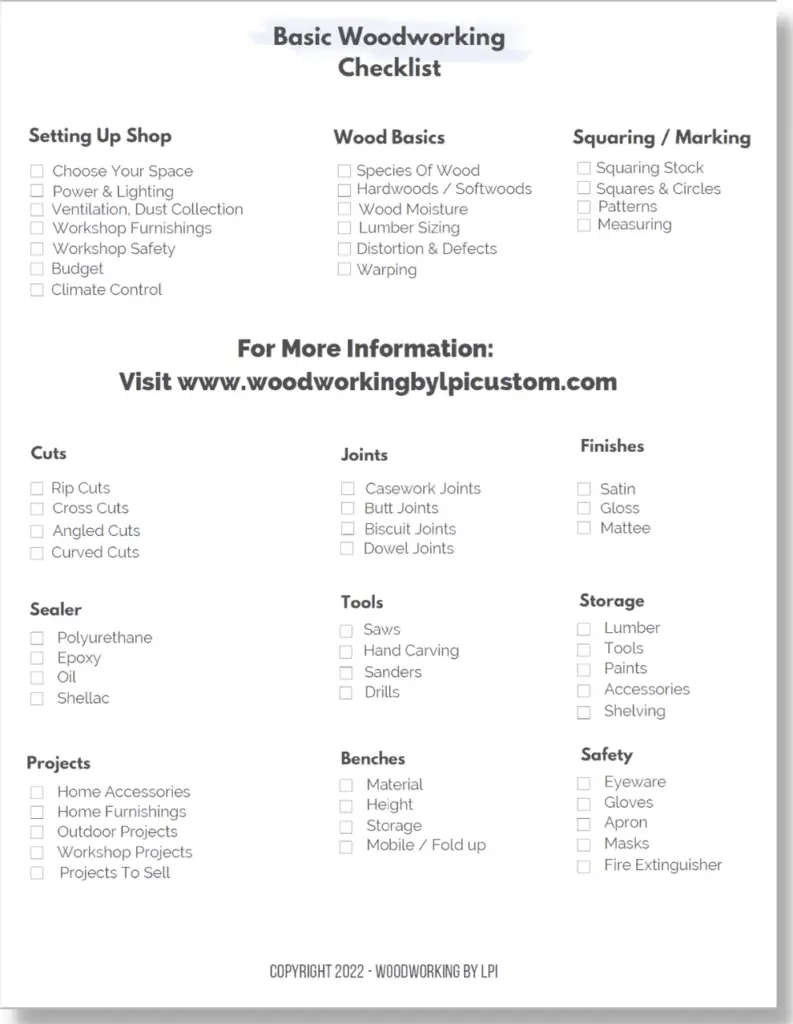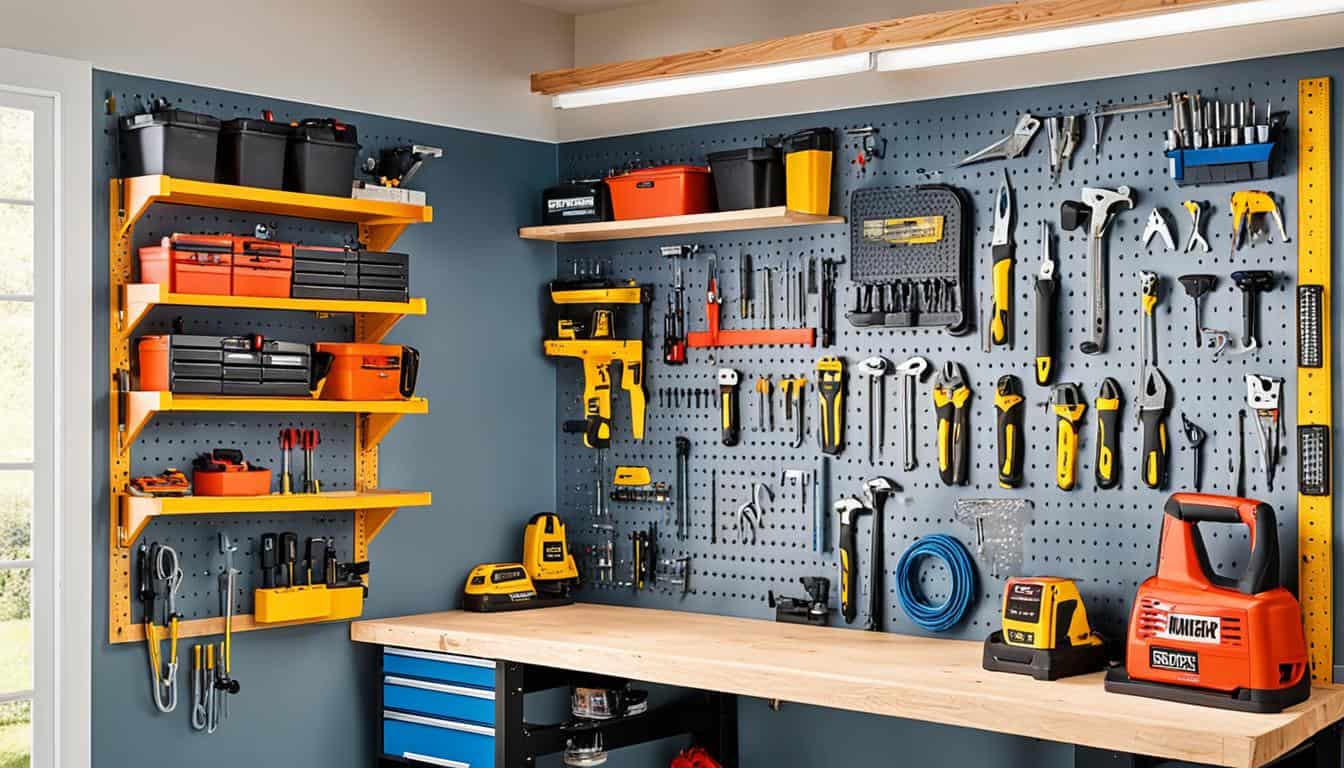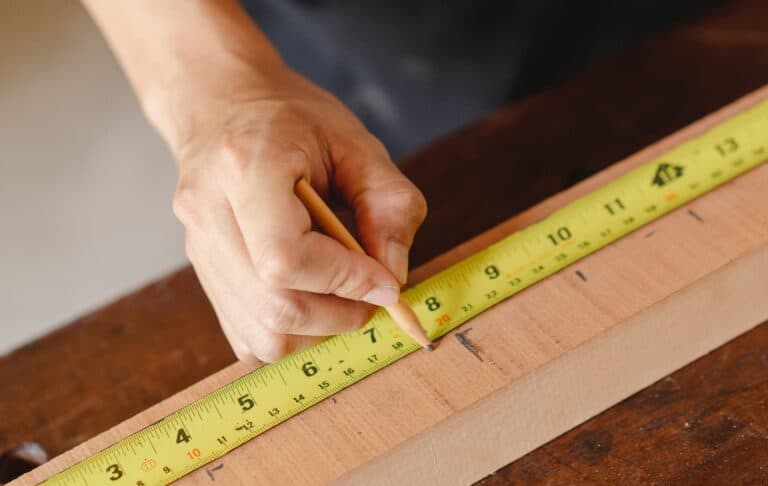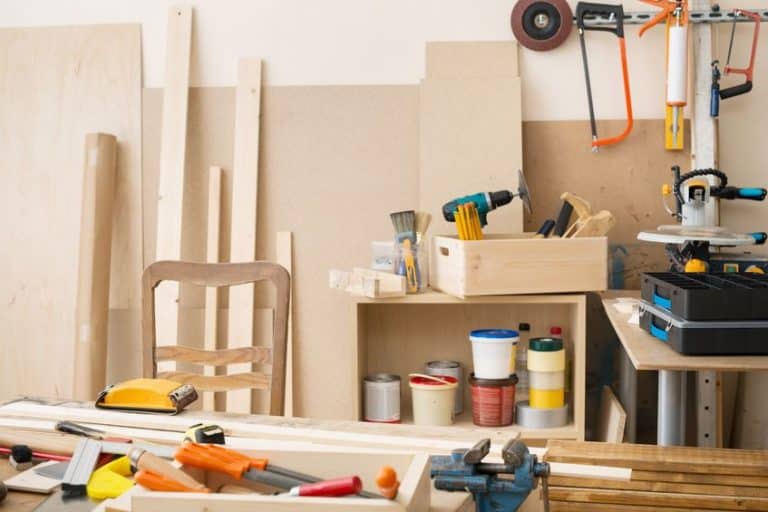When setting up your workspace, having an ideal workbench is essential. The dimensions of your workbench play a crucial role in ensuring comfort and productivity. In this guide, we will explore workbench dimensions and help you choose the right size for your specific needs.
Standard workbench sizes may not always be suitable for every workspace. Therefore, it is important to consider the available space and your specific requirements when determining the dimensions of your workbench. By choosing the right dimensions, you can maximize efficiency and create a functional workspace.
Key Takeaways:
- Choosing the right workbench dimensions is crucial for comfort and productivity.
- Consider the available space in your workspace when determining the dimensions.
- Standard workbench sizes may not always meet your specific requirements.
- Customizable and adjustable workbench dimensions offer flexibility for different projects.
- Take into account factors such as workbench height, depth, width, and tool storage needs.
Factors to Consider when Choosing Workbench Dimensions
When selecting workbench dimensions, there are several factors to consider. One important factor is the ideal workbench height, which should allow for comfortable working without straining your back or shoulders. Additionally, workbench measurements should be taken into account, considering the type of projects you will be working on and the available space in your workshop. It is also crucial to choose dimensions that suit your personal preferences and working style.
Achieving the ideal workbench height is essential for maintaining proper posture and reducing strain on your body while working for extended periods. An adjustable workbench with varying height options is highly recommended to accommodate individuals of different heights and working preferences.
When determining the workbench measurements, consider both the width and depth of the workbench. The width should provide adequate workspace for your projects, tools, and materials, while the depth should allow for comfortable movement and reach without hindering your range of motion.
It’s important to choose the workbench dimensions that are best suited for your specific needs. If you primarily work on small-scale projects or have limited space, a compact workbench with smaller measurements may be sufficient. On the other hand, if you work on larger projects or require more workspace, a larger workbench with spacious dimensions would be more suitable.
Remember, finding the right workbench dimensions is a personalized process that depends on your unique requirements. Consider the type of work you do, the available space in your workshop, and your own preferences and comfort when selecting the ideal workbench measurements.
The Importance of Adjustable Workbench Dimensions
Having an adjustable workbench allows for versatility and adaptability. With adjustable workbench dimensions, you have the flexibility to modify the height, width, and depth of the workbench to suit different projects and tasks. This feature is especially valuable if you share your workspace or if multiple people will be using the workbench with varying comfort requirements.
When it comes to adjustable workbench dimensions, you have the freedom to customize your workspace to match your specific needs. Whether you’re working on intricate woodworking projects that require a lower height or tackling large-scale DIY tasks that demand additional width and depth, an adjustable workbench allows you to make the necessary adjustments.
“Having an adjustable workbench has been a game-changer in my workshop. I can easily switch between woodworking and metalworking projects by simply adjusting the dimensions to match the task at hand. It saves me time and effort, and ensures that I can work comfortably no matter what I’m working on.” – Mark Johnson, Professional Craftsman
Additionally, adjustable workbench dimensions provide ergonomic benefits. By customizing the height of your workbench, you can ensure that you maintain the right posture and minimize strain on your back and shoulders. This is particularly important if you spend long hours working at your bench.
Benefits of Adjustable Workbench Dimensions:
- Adaptability: Adjust the dimensions to accommodate different projects and tasks.
- Shared Workspaces: Multiple users can customize the workbench to their comfort requirements.
- Ergonomic Support: Modify the height to maintain proper posture and reduce strain.
- Efficiency: Create a workspace that maximizes productivity and minimizes unnecessary movements.
Investing in an adjustable workbench with customizable dimensions is a wise choice for anyone looking to create a versatile and comfortable workspace. It allows you to optimize your efficiency, adapt to varying project requirements, and ensure that you can work comfortably for extended periods.
| Features | Benefits | |
|---|---|---|
| Adjustable Height | Customize the height to match your comfort level. |
|
| Flexible Width and Depth | Easily modify the dimensions to accommodate various projects. |
|
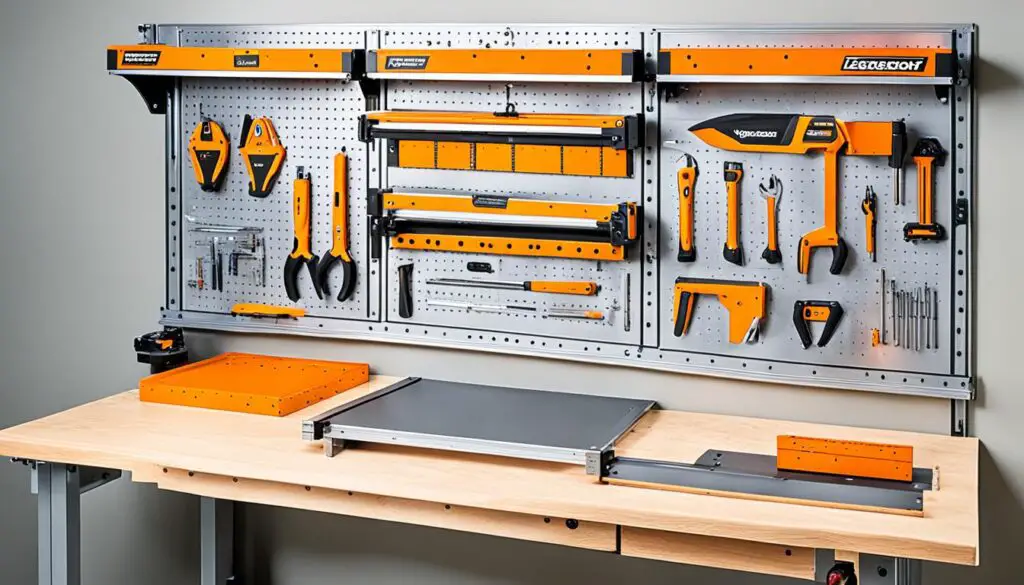
By investing in an adjustable workbench, you can create a workspace that perfectly aligns with your needs, allowing you to work with ease and efficiency. Whether you’re a professional craftsman, hobbyist, or DIY enthusiast, adjustable workbench dimensions give you the freedom to customize your work area for optimal performance.
Standard Workbench Sizes
When it comes to choosing the dimensions for your workbench, standard sizes can be a helpful starting point. These sizes are designed to accommodate a range of workstations and projects, providing a good foundation for creating an efficient workspace.
Standard workbench sizes typically range from 48″ x 24″ for smaller, lighter workstations to larger sizes such as 72″ x 30″ for primary workbenches. These dimensions offer a balance between workspace and maneuverability, allowing for comfortable and productive work.
Keep in mind that while standard sizes can be suitable for many situations, it’s essential to evaluate your specific needs and requirements before making a final decision. Factors such as the size of your workspace, the type of projects you’ll be working on, and the tools you’ll be using should all be considered.
If your workspace has limited space or you have unique project requirements, custom dimensions may be necessary. Custom workbench dimensions can be tailored to your specific needs, allowing you to maximize efficiency and functionality within your workspace.
To help you visualize the standard workbench sizes, take a look at the table below:
| Workbench Size | Dimensions (inches) |
|---|---|
| Small/light-duty workbench | 48″ x 24″ |
| Medium-duty workbench | 60″ x 30″ |
| Primary workbench | 72″ x 30″ |
Remember, this table is just a general guide. The ideal workbench size for you may vary depending on your specific needs and available space.
Now that you have an understanding of standard workbench sizes, let’s explore the optimal depth for a workbench in the next section.
The Optimal Workbench Depth
The depth of a workbench is a critical dimension to consider when designing your workspace. It directly impacts your comfort, productivity, and the amount of available workspace for your projects and equipment.
For lighter tasks or limited space, a workbench with a depth of 24″ can be sufficient. This depth provides a functional workspace without taking up excessive room in your workshop.
However, if you frequently tackle larger projects or require extra space for additional equipment, a deeper workbench of 30″ or more is recommended. The added depth allows for more room to spread out your tools, materials, and workpieces, ensuring you have ample space to work comfortably.
When choosing the optimal workbench depth, it’s essential to strike a balance. You want a depth that provides enough space for your projects but doesn’t restrict your movement or clutter the benchtop. Finding the right depth will enhance your workflow and make your workbench a versatile and efficient workspace.
Benefits of an Optimal Workbench Depth:
- Ample workspace for projects of different sizes
- Enough room for additional tools and equipment
- Comfortable working environment
- Improved organization and efficiency
By considering the optimal workbench depth, you can create a workspace that caters to your specific needs and ensures a productive and enjoyable work experience.
Workbench Width and Reach
When setting up your workbench, it’s important to consider its width to ensure you have adequate reach while working. The width of your workbench determines how much space you have available for your projects and tools.
Standard workbench widths typically range from 24″ to 30″. A width of 24″ is suitable for most tasks and provides enough room for your work. However, if you have larger projects or need more space to accommodate multiple tools, a wider workbench of around 30″ can be a great option.
The key is to choose a workbench width that aligns with your working style and the reach required for your projects. A wider workbench allows for more surface area to spread out your tools and materials, making it easier to work efficiently.
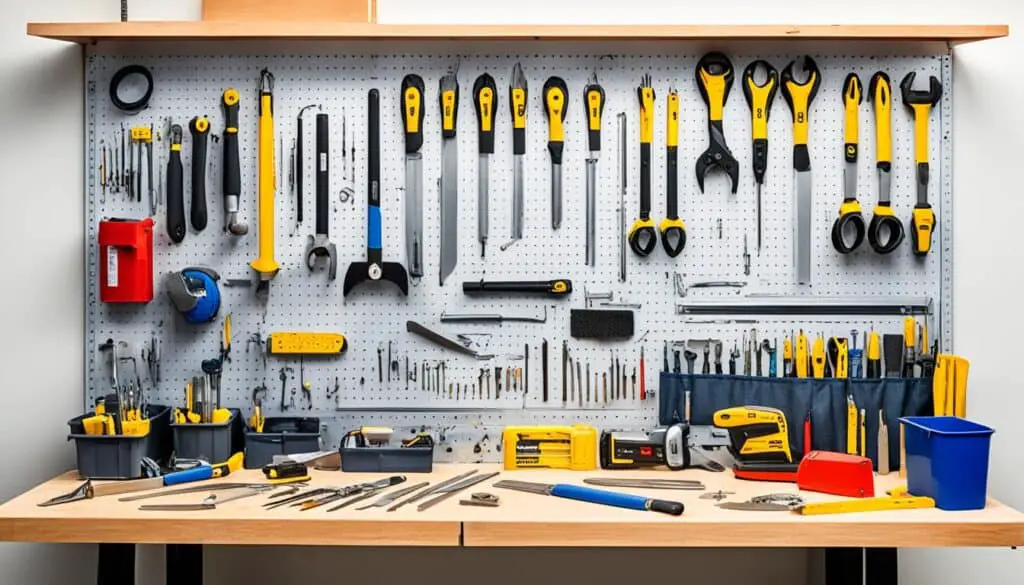
Benefits of a Wider Workbench:
- Ample space for larger projects
- Comfortably accommodate multiple tools
- Reduced clutter on the work surface
Having a wider workbench can make a significant difference in your workspace. It provides you with more room to organize your tools and materials, allowing for a more streamlined and efficient workflow. With a wider workbench, you can focus on your tasks without the distractions of limited space.
Standard Workbench Widths:
| Workbench Width | Recommended Usage |
|---|---|
| 24″ | Most common size for general tasks |
| 30″ | Provides additional workspace for larger projects and multiple tools |
Custom Workbench Dimensions
For those with specific requirements or unique workspace constraints, custom workbench dimensions offer the flexibility to create a bench tailored to your needs. By building your own workbench, you can determine the ideal height, width, and depth that will maximize efficiency and comfort in your workspace.
When opting for custom workbench dimensions, consider the following factors:
- The available space in your workshop
- The type of projects you will be working on
- Your preferred working style and comfort requirements
Custom workbenches allow you to optimize your workspace by creating a bench that perfectly fits your needs. Whether you need a compact bench for a small workshop or an expansive bench for large-scale projects, custom dimensions ensure that every inch of your workbench is utilized effectively.
To determine the dimensions for your custom workbench, consider the specific tasks you will be performing. If you require ample space for assembly work, a wider bench may be necessary. Alternatively, if you primarily work with smaller tools, a narrower bench with additional storage options may be a better choice.
Remember to also factor in ergonomics and comfort when designing your custom workbench. Ensure that the height is appropriate for your work style and body mechanics to prevent strains and injuries. Adjustable workbench legs can be a valuable addition, allowing you to fine-tune the height as needed.
To inspire your custom workbench design, here is an example of a table highlighting various custom workbench dimensions:
| Custom Workbench Dimensions | Ideal Use | Recommended Depth | Recommended Width | Recommended Height |
|---|---|---|---|---|
| Compact Workbench | Small workshops or limited spaces | 24″ | 48″ | 36″ |
| Standard Workbench | Versatile use, suitable for most projects | 30″ | 60″ | 36″ |
| Wide Workbench | Assembly work, large projects | 36″ | 72″ | 36″ |
Custom workbench dimensions offer the freedom to create a workspace that perfectly aligns with your needs. Whether you require a compact bench or a spacious one, designing a bench with custom dimensions ensures that you can work efficiently and comfortably in your workshop.
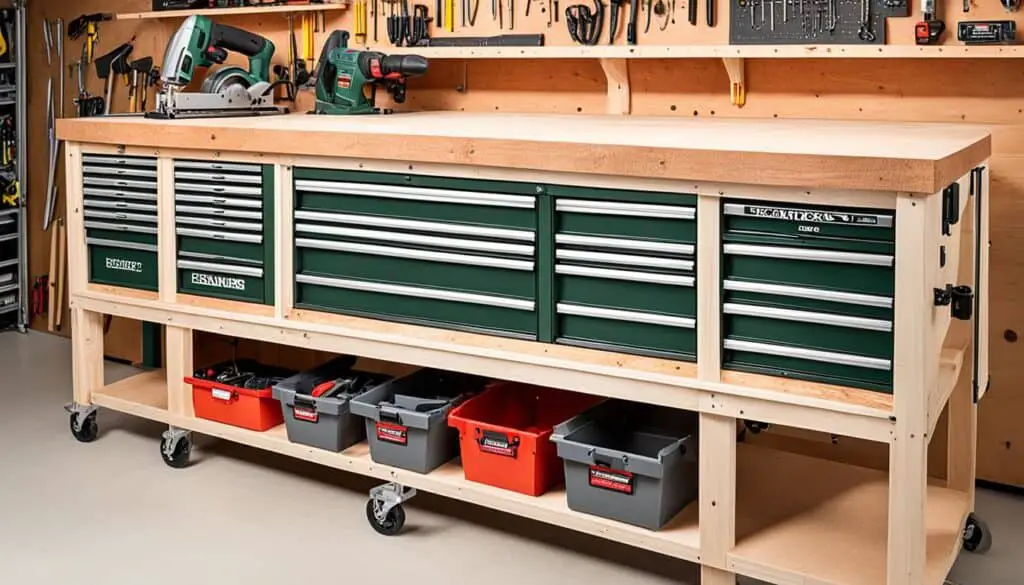
Ideal Workbench Height
The ideal workbench height is crucial for maintaining proper posture and reducing strain on the body. Working at a height that is too low or too high can lead to discomfort and potential long-term health issues. While the standard workbench height is around 36″, it’s important to find the height that suits your specific needs.
Adjustable workbench legs have gained popularity due to their ability to personalize the height based on individual comfort and working requirements. These legs allow you to easily raise or lower the workbench to the desired height, providing a customizable and ergonomic solution for your workspace. Whether you’re taller or shorter than average, adjustable workbench legs ensure that you can work comfortably and efficiently.
Benefits of an Adjustable Workbench Height:
- Improved posture: By setting the workbench at the right height for your body, you can maintain proper posture and prevent strain on your back, neck, and shoulders.
- Reduced fatigue: Working at the ideal height reduces the strain on your body, resulting in less fatigue and increased productivity.
- Flexibility: Adjustable workbenches can accommodate different tasks and projects, allowing you to work comfortably whether you’re standing or sitting.
- Shared workspace compatibility: If you share your workspace with others who have different height requirements, an adjustable workbench can easily be adjusted for each user.
Investing in an adjustable workbench with customizable height options is a wise choice for those seeking optimal comfort and efficiency in their workspace. The ability to adapt the height to your specific needs ensures a healthier and more productive work environment.
| Standard Workbench Height (in inches) | Benefits |
|---|---|
| Around 36″ | – Fits most individuals – Provides a good balance between standing and sitting positions |
| Adjustable | – Personalized height options – Improved comfort and ergonomics – Suitable for shared workspaces |
Finding the Right Workbench Length
When it comes to workbench length, finding the right fit is crucial for optimizing your workspace. The length of your workbench depends on two key factors – the available space in your workshop and the type of projects you’ll be working on. By considering these factors, you can determine the optimal workbench length that suits your needs.
Standard workbench lengths typically range from 6 to 8 feet, providing ample workspace for various tasks. However, shorter workbenches measuring around 5 feet can still offer adequate space, especially for smaller projects or if your workshop has limited area. Evaluating the size of your projects and the available space in your workshop will help you determine the right length for your workbench.
Table: Workbench Length Options
| Standard Length (feet) | Recommended For |
|---|---|
| 5 | Smaller tasks, limited workshop space |
| 6-8 | Versatile workspace, medium to large projects |
Remember, choosing a workbench length that suits your specific needs is essential for maximizing productivity and efficiency. Whether you opt for a standard length or decide to customize it, ensuring your workbench provides adequate workspace is key to a successful woodworking or DIY experience.
Custom Workbench Lengths
If your workspace has unique constraints or you have specific requirements, consider opting for a custom workbench length. Customizable workbenches allow you to tailor the dimensions of your workbench to your exact specifications. This can be particularly beneficial if you have limited space or if you work on specialized projects that require a specific length.
By customizing your workbench length, you can create a workspace that meets your precise needs, making it easier to tackle projects efficiently and comfortably. Whether you choose a standard length or decide to go custom, finding the right workbench length is essential for creating a productive and enjoyable workspace.
Workbench Dimensions and Tool Storage
When designing your workbench, it’s important to consider not only the dimensions of the work surface but also the storage and organization systems that will be incorporated into the bench. Tool storage plays a crucial role in keeping your workspace tidy and efficient, and it must be taken into account when selecting or designing your workbench dimensions.
Adding cabinets, drawers, or shelving units to your workbench will help you keep your tools and accessories organized and easily accessible. However, it’s essential to ensure that the dimensions of these storage systems don’t impede the functionality or accessibility of your workbench. Additional depth or width may be required to accommodate the storage compartments, depending on the size and quantity of tools you have.
By considering your tool storage needs in conjunction with the workbench measurements, you can create a workspace that optimizes both functionality and efficiency. Having the right storage dimensions and layout will make it easier for you to locate and retrieve tools during your projects, saving you valuable time and eliminating potential frustrations.
Here’s an example of a workbench dimensions and tool storage configuration:
| Workbench Dimensions | Tool Storage |
|---|---|
| Height: 36″ | One large cabinet with multiple shelves |
| Depth: 24″ | Three drawers for small hand tools |
| Width: 60″ | Two wall-mounted pegboards for easy access |
This configuration showcases a workbench with dimensions suitable for most projects. The height of 36″ provides a comfortable working position. The depth of 24″ allows for ample workspace, while the width of 60″ accommodates tool storage options. The large cabinet and three drawers offer storage for tools based on their size and frequency of use, while the wall-mounted pegboards provide additional hanging space for frequently accessed tools.
Remember, finding the right balance between workbench measurements and tool storage is essential. Tailoring your workbench dimensions to accommodate your specific tool storage needs will enhance the overall functionality and organization of your workspace, allowing you to work efficiently and effectively.
Choosing the Right Workbench Dimensions for Hand Tools
If you primarily use hand tools in your woodworking or DIY projects, it’s important to adapt your workbench dimensions to accommodate these tools effectively. When determining the ideal bench depth, width, and height, consider the size and reach of your hand tools. This will allow for comfortable and efficient use of your hand tools on the workbench.
Hand tools come in various sizes, from small precision tools to larger hand saws and drills. To ensure optimal functionality and usability, your workbench should provide enough space for you to comfortably handle and manipulate these tools.
Begin by considering the depth of your workbench. A depth of 24 inches is often suitable for lighter tasks and smaller hand tools. However, if you frequently work with larger tools or need more space for assembly work, a deeper workbench, such as 30 inches or more, may be more appropriate.
Next, think about the width of your workbench. A standard width of 24 inches can usually accommodate most hand tools. However, if you have more tools or need additional workspace for your projects, consider a wider workbench of around 30 inches. This extra width will provide you with more room to organize your tools and work comfortably.
Finally, let’s discuss the height of your workbench. Since hand tools require precision and control, it’s important to have a workbench at a comfortable height. The ideal workbench height for hand tool work is typically around 36 inches. However, consider your own height and preferences when determining the perfect height for you. Some individuals may prefer a slightly higher or lower workbench to avoid straining their backs or shoulders.
Remember, the goal is to create a workbench that allows you to work efficiently and comfortably with your hand tools. By adapting the dimensions of your workbench to accommodate your tools and working style, you’ll enhance your overall woodworking experience.
To visualize these recommendations, take a look at the table below:
| Hand Tool Size | Ideal Bench Depth | Ideal Bench Width |
|---|---|---|
| Small Precision Tools | 24 inches | 24 inches |
| Medium-sized Hand Tools | 24 inches | 24 inches |
| Large Hand Tools | 30 inches or more | 30 inches or more |
Remember, these dimensions serve as a general guideline. Always adjust your workbench dimensions based on your specific tools, projects, and personal preferences. By customizing your workbench to accommodate your hand tools, you’ll create a workspace that fosters efficiency, comfort, and enjoyment in your woodworking endeavors.
The Benefits of Customizable Workbench Dimensions
Having customizable workbench dimensions provides numerous benefits. With custom or adjustable dimensions, you can create a workspace that perfectly fits your needs, maximizing productivity and comfort. Customizable workbenches also allow for future modifications as your needs change or your workspace evolves.
When it comes to workbenches, one size does not fit all. Every individual has unique preferences, projects, and space constraints. That’s where customizable workbench dimensions come in. By tailoring the dimensions to your specific requirements, you can optimize your workbench for maximum efficiency and functionality.
Whether you need a larger surface area for spreading out materials or a narrower bench for tight spaces, adjustable workbench dimensions allow you to create the perfect setup. You can choose the ideal height, width, and depth to suit your working style, ensuring a comfortable and ergonomic workspace.
Customizable workbench dimensions also provide the flexibility to adapt to changing needs over time. As your projects evolve or your workspace expands, you can easily modify the dimensions to accommodate new requirements. This eliminates the need for purchasing a completely new workbench and saves you both time and money.
Furthermore, adjustable workbench dimensions are particularly beneficial for shared workspaces or collaborative environments. With the ability to customize the bench to each user’s preferences, everyone can work comfortably and efficiently. This promotes productivity and reduces the risk of discomfort or injuries caused by working at an ill-fitting workbench.
Whether you are a hobbyist, a professional craftsman, or a DIY enthusiast, having customizable workbench dimensions empowers you to create a workspace that meets your exact needs. It offers flexibility, adaptability, and personalization, enhancing both the functionality and aesthetics of your work area.
Investing in a workbench with customizable dimensions is an investment in your productivity and overall work experience. By tailoring the dimensions to your specific requirements, you can optimize your workbench for maximum efficiency, allowing you to focus on what you do best – creating with confidence.
So why settle for a standard workbench size when you can have a custom solution that perfectly aligns with your needs?
| Benefits of Customizable Workbench Dimensions |
|---|
| 1. Tailored to your specific requirements |
| 2. Optimizes productivity and comfort |
| 3. Allows for future modifications and adaptations |
| 4. Ideal for shared workspaces |
| 5. Enhances functionality and aesthetics |
Conclusion
Determining the ideal workbench dimensions is crucial for creating a productive and comfortable workspace. By considering factors like available space, types of projects, personal preferences, and tool storage requirements, you can find the perfect fit for your needs.
While standard workbench sizes can serve as a starting point, customization and adjustable options offer greater flexibility. Tailoring the dimensions to your specific requirements allows for a more efficient and personalized workspace.
Maximizing efficiency and comfort in your workshop is essential for enhancing productivity and enjoying your work. Therefore, take the time to carefully evaluate the ideal workbench dimensions for your space. Whether you follow a workbench size guide or create custom dimensions, finding the right balance will help you create a workspace that supports your workflow and ensures a satisfying experience.
Investing in the ideal workbench dimensions is an investment in your craft and yourself. So, take into account all the necessary considerations, and create a workspace that inspires creativity and allows you to work at your best.
FAQ
What factors should I consider when choosing workbench dimensions?
When choosing workbench dimensions, factors to consider include the ideal workbench height, workbench measurements, and personal preferences.
Why are adjustable workbench dimensions important?
Adjustable workbench dimensions provide flexibility and adaptability, allowing you to customize the height, width, and depth of the workbench to fit different projects and tasks.
What are the standard workbench sizes?
Standard workbench sizes range from 48″ x 24″ for smaller workstations to larger sizes such as 72″ x 30″ for primary workbenches.
How do I determine the optimal workbench depth?
The depth of a workbench depends on the type of tasks you’ll be working on. A bench with a depth of 24″ may suffice for lighter tasks, while a deeper bench of 30″ or more provides more workspace for larger projects.
What should I consider when it comes to workbench width and reach?
The width of a workbench should allow for adequate reach while working. A wider bench of around 30″ provides more space for projects and tools, depending on your working style and reach requirements.
Can I get a workbench with custom dimensions?
Yes, you can get a workbench with custom dimensions to suit your specific needs and workspace constraints.
What is the ideal workbench height?
A workbench height of around 36″ is considered standard and suitable for most individuals. However, adjustable workbench legs allow for personalization based on comfort and working requirements.
How do I determine the right workbench length?
The length of a workbench depends on the space available and the type of projects you’ll be working on. Standard lengths range from 6 to 8 feet, but shorter workbenches of 5 feet can still provide adequate workspace for smaller tasks.
What should I consider regarding workbench dimensions and tool storage?
When considering workbench dimensions, you should account for any tool storage or organization systems that will be incorporated into the bench, as they may require additional depth or width for proper functionality and accessibility.
How do I choose the right workbench dimensions for hand tools?
When choosing workbench dimensions for hand tools, consider the size and reach of your hand tools to ensure comfortable and efficient use on the workbench.
What are the benefits of customizable workbench dimensions?
Customizable workbench dimensions allow for a tailored workspace that maximizes productivity and comfort. They also provide the flexibility for future modifications as needs change.
What should I consider when determining ideal workbench dimensions?
When determining ideal workbench dimensions, consider factors such as available space, types of projects, personal preferences, and tool storage requirements.

